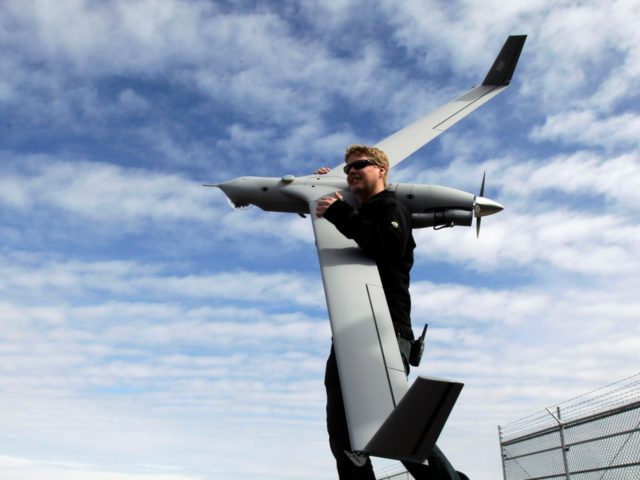U.S. President Donald Trump’s administration will sell 34 surveillance drones to four American allies in the South China Sea, Reuters reported Tuesday.
The original announcement, made on Friday, came a few days before Gen. Wei Fenghe, China’s defense minister, warned during an annual security conference in Singapore that Beijing’s military will “resolutely take action” to defend Chinese claims over sovereign Taiwan and disputed South China Sea waters. China claims control over all of Taiwan’s territory and waters, according to the Associated Press (AP).
The Chinese defense chief did not explicitly direct his hostility towards the United States, which is also engaged in a trade dispute with Beijing.
Acting U.S. Defense Secretary Patrick Shanahan spoke at the same event in Singapore on Saturday, but was not present during Gen. Wei’s comments, AP reports.
At the same event, however, the Pentagon chief warned on Saturday that the United States would no longer “tiptoe” around China’s strong-arm tactics currently tormenting American allies in Asia, Reuters notes.
Like his Chinese counterpart, Shanahan refrained from naming Beijing when levying accusations of “actors” destabilizing the region. The Pentagon chief reportedly cautioned the United States would no longer ignore Chinese actions.
The new drones allow American allies to intensify intelligence gathering capabilities to tame Chinese activities in and around the South China Sea.
Reuters reports:
The Pentagon announced on Friday it would sell 34 ScanEagle drones, made by Boeing Co. to the governments of Malaysia, Indonesia, the Philippines and Vietnam for a total of $47 million.
China claims almost all of the strategic South China Sea and frequently lambastes the United States and its allies over naval operations near Chinese-occupied islands. Brunei, Indonesia, Malaysia, the Philippines, Taiwan, and Vietnam have competing claims.
The Pentagon said Friday’s sales included spare and repair parts, support equipment, tools, training and technical services and work on the equipment was expected to be completed by March 2022.
As many as 12 unarmed drones and equipment would go to Malaysia for about $19 million. Indonesia, the world’s largest Muslim-majority country would buy eight drones, the Philippines eight, and Vietnam six.
Echoing independent assessments and an American bipartisan study, U.S. Indo-Pacific Command’s (INDOPACOM) warned in February that Beijing is also using its military to advance its territorial claims in the East China Sea
The East China Sea dispute revolves around growing tensions between China and Japan over century-old territorial claims to a set of islands known as the Senkakus in Japan and the Diaoyus in China. Japan has administered the islands since 1972.
“An accidental military incident or political miscalculation by China or Japan could embroil the United States in armed hostilities with China,” the Council on Foreign Relations (CFR) cautioned in 2018.
Under Trump, the United States has reportedly eased rules surrounding America’s lethal and non-lethal arms exports policy to increase sales to allies while creating jobs by boosting domestic production.
The long-awaited overhaul allows the United States to sale drones “to potentially dozens more allies and partners,” Reuters points out.
Without naming the countries, AP reiterated over the weekend that China is currently assembling a pact with four rival claimants from the Association of Southeast Asian Nations (ASEAN), “containing norms and rules aimed at preventing a shooting war in the disputed waters.”
Brunei, Vietnam, Malaysia, Indonesia, and the Philippines are all ASEAN members. During his trip to the annual event in Singapore over the weekend, the Pentagon chief met with high-level officials from at least two of those ASEAN members: Vietnam and Malaysia.
Amid growing U.S.-China tensions over Beijing’s territorial disputes in the South China, the United States has flexed its military muscle in support on its allies on several occasions in recent years.
INDOPACOM, however, has repeatedly warned that China’s “massive effort to grow and modernize” its armed forces is “eroding” the United States’ “relative competitive military advantage” in its area of responsibility (AOR), which includes the South China Sea.
The AOR covers 36 nations in the Indo-Asia-Pacific region that house more than half of the world’s population.
In INDOPACOM’s annual mission and goals report to Congress unveiled in February, Adm. Philip Davidson, the top commander in the region, warned:
Our military advantage and deterrent edge in the Indo-Pacific is eroding. The Chinese Communist Party leadership in Beijing senses weaknesses. They are testing our resolve, and if we do not act urgently, they may soon conclude that they can achieve their goals through force.
The INDOPACOM commander described Beijing’s actions on the South China Sea as a significant threat against the U.S.-led “international order.”
In 2018, China “continued militarizing” its outposts on the South China Sea, he added.
Adm. Harris noted in his 2018 annual report to American lawmakers that Beijing has already “developed and fielded capability and capacity to challenge our regional maritime dominance,” referring to America’s naval capabilities in INDOPACOM’s area of responsibility.
Beijing’s “impressive military buildup” may soon enable the PLA to challenge America’s military dominance in the Indo-Pacific region “across almost all domains,” the top admiral cautioned in February 2018.
Under President Trump, the American military is prioritizing combating strategic competitors China and Russia over everything else, including the war on terror.

COMMENTS
Please let us know if you're having issues with commenting.